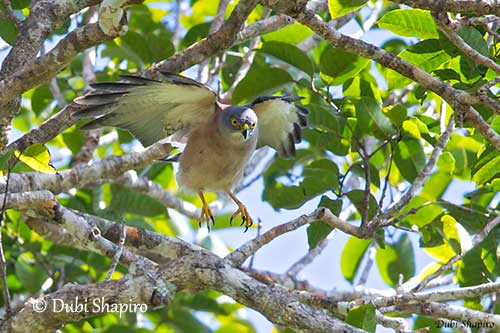
The Fiji Goshawk is usually seen alone or in pairs. However, family groups are reported after the breeding season.
Some aerial behaviour is reported, mainly high-circling, but no “sky-dance”. Chases have been observed accompanied by high-pitched piping sounds. The birds also perform dives with arched tail.
The Fiji Goshawk is almost entirely sedentary, but some dispersal, probably by juveniles, may occur towards small islands.
The flight includes strong wingbeats interspersed with short glides on flat wings. This raptor also soars on level wings with slightly upcurved and fingered tips.
REPRODUCTION OF THIS SPECIES:
The breeding season occurs between July-August and November-December, with peak of laying in September-October.
Late renesting may occur between February and May, usually after cyclones that may disturb the breeding season.
The Fiji Goshawk nests solitary, but they may nest sometimes 400 metres apart. The large platform is made with sticks and lined with leaves. It is placed between 6 and 16 metres above the ground, sometimes up to 25 metres in lightly foliaged tree, often Fabaceae.
The female lays 2-3 (1-4) eggs. Broods of two fledglings are common.
No information on incubation and nesting periods.
PROTECTION / THREATS / STATUS:
The Fiji Goshawk has reduced range in Fiji, but the population density is high. In addition, some islands of the range still have much original forest, extensive pine plantations and widespread exotic secondary growths.
This species is persecuted and shot because it takes chickens, and it is vulnerable to pesticides involving thinner eggshell.
The population is roughly estimated to number 670/6,700 mature individuals and appears to be stable.
The Fiji Goshawk is not globally threatened and currently evaluated as Least Concern.
Fr: Autour des Fidji
Ang: Fiji Goshawk
All: Fidschihabicht
Esp: Gavilán de las Fiji
Ita: Astore delle Figi
Nd: Fijihavik
Sd: fijihök
Photographer:
Dubi Shapiro
Dubi Shapiro Photo Galleries & Dubi Shapiro's Pictures on IBC
Text by Nicole Bouglouan
Sources:
HANDBOOK OF THE BIRDS OF THE WORLD Vol 2 by Josep del Hoyo-Andrew Elliot-Jordi Sargatal - Lynx Edicions - ISBN: 8487334156
RAPTORS OF THE WORLD by James Ferguson-Lees et David Christie - Helm Identification Guides – ISBN: 0713680261
Wikipedia, the free encyclopaedia
Global Raptor Information Network - Working to Conserve Birds of Prey in nature
Fiji Goshawk (Accipiter rufitorques) hunts by grass-probing
Fiji Goshawk
Accipiter rufitorques
Accipitriformes Order – Accipitridae Family
INTRODUCTION:
The Fiji Goshawk is endemic to Fiji and occurs on the larger islands of the archipelago. It frequents a variety of wooded habitats from sea-level to 1,200 metres of elevation.
It is a medium-sized raptor and the female is larger than the male. The soft-coloured plumage makes this raptor unmistakable.
The Fiji Goshawk feeds on birds, insects, rodents and reptiles. It hunts from perches or on the wing. It nests in tree and up to two chicks are commonly fledged.
It is persecuted and shot because it kills chickens, but it is relatively common throughout the range. The species is not currently threatened.
DESCRIPTION OF THE BIRD:
Biometrics:
Length: 30-42 cm
Wingspan: 58-73 cm
Weight: M: 190-209 g – F: 281 g
The Fiji Goshawk has pale smoky-grey upperparts, including wings and unbarred tail. The primary flight-feathers are slightly darker grey. The nuchal collar is vinous-pink.
On the underparts, chin and throat are whitish. Rest of underparts is pale pink faintly suffused with pale grey. Vent and undertail-coverts are pinkish-white. The underwing is whitish with indistinct pale grey bars on the dark grey flight-feathers. The underside of the tail is grey.
The head is smoky-grey.
The bill is black with yellow cere. The eyes are deep orange-red or orange-yellow. The stout legs and feet are orange-yellow with black claws.

The female resembles male but she is 11/25% larger. She has more rufous collar and the underparts are darker greyish-pink, with sometimes indistinct whitish barring.
The juvenile has dark brown upperparts with rufous-edged feathers in fresh plumage. The head may appear streaked and the nuchal collar is paler. Uppertail and secondaries are slightly barred grey-brown.
The underparts are mostly creamy-white to rufous with conspicuous blackish and rufous streaking. Flanks and thighs are mostly barred brown and rufous. The undertail is buffy-white with several narrow dark bars. The eyes are yellow.
RANGE:
The Fiji Goshawk is found on several large islands of Fiji archipelago such as Viti Levu, Vanua Levu, Taveuni, Kadavu, Gau and Ovalau. It is absent from the SE islands.
HABITAT:
The Fiji Goshawk frequents wooded habitats from dense rainforest and open woodland to cultivated areas with scattered trees and urban parks.
The species is visible from sea-level to 1,200 metres of elevation.
CALLS AND SONGS: SOUNDS BY XENO-CANTO
The Fiji Goshawk is usually noisy in the evening, but also near the nest and with fledged young.
It gives strident “ki…ki…ki…” and also high, thin “shee-shee-shee” and a rapidly repeated “weit-weit-weit…” sometimes followed by interrogative “queerk? queerk? queerk?
BEHAVIOUR IN THE WILD:
The Fiji Goshawk feeds on various prey including birds (small and medium-sized) such as introduced Common Myna and Barking Imperial Pigeon, but also chickens. It also catches insects, lizards and snakes, and introduced rodents.
It has also been recorded feeding on freshwater crustaceans and fish, but only occasionally.
The juveniles may eat carrion, but an observation describes young birds probing repeatedly into the grass with their feet, in order to catch hidden small passerines. These small birds land on the grass and disappear beneath it, probably to feed on the ground. The young raptor made three attempts but all were unsuccessful.
The Fiji Goshawk hunts from perches but it also forages by flying low with fast twisting flight, and using the vegetal cover to maintain surprise. It pursues the prey into dense vegetation where it actively harasses it and blocks any escape with its spread wings. Other prey can be taken in flight after rapid take-off from perch or ground.
